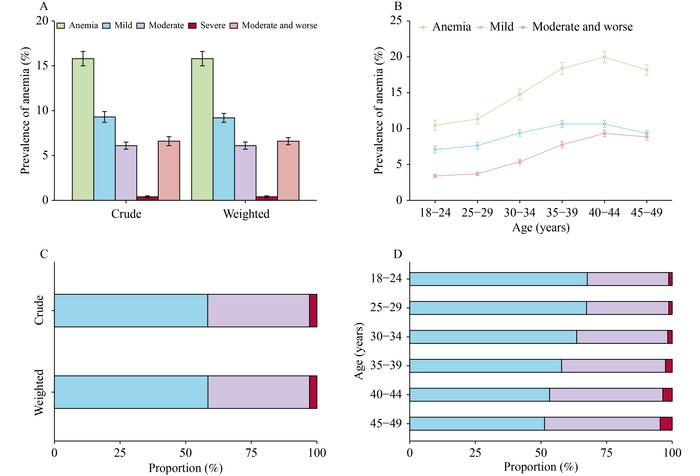Anemia, a prevalent health issue globally, affects millions, with women being disproportionately impacted due to various biological and socio-economic factors. Recent findings from a groundbreaking study in China unveil alarming insights into the prevalence of anemia among women of reproductive age. The study’s comprehensive data collection and analysis process involved over 571 million women, elucidating the connections between anemia and metabolic factors such as obesity and overweight. This connection offers new avenues for intervention and highlights the necessity of tailored public health strategies to mitigate anemia’s effects on women.
This nationwide, population-based study meticulously gathered data from the Meinian Healthcare Group system, a significant resource for public health research in China. The researchers focused on non-pregnant women aged 18 to 49, employing a hemoglobin threshold of <120.0 g/L to define anemia. The study stratified conditions into mild, moderate, and severe categories, with a startling 41.5% of the cases being classified as moderate or worse. Such nuances profoundly inform our understanding of anemia’s varied manifestations and the demographic disparities that characterize its prevalence.
From 2013 to 2019, global trends indicated a concerning increase in the prevalence of anemia among women. The study documented a rise from 28.5% to 29.9% during this period, signaling an urgent need for effective public health strategies. Anemia arises from numerous factors, including nutrient deficiencies, chronic infections, and gendered socio-economic disparities. Within China, geographic and demographic variations further complicate the anemia landscape, underpinning the need for localized efforts to address this pressing public health concern.
Analyzing geographic trends reveals striking disparities in anemia prevalence across different provinces. Regions such as Xizang exhibited the highest rates, while Guizhou reported the lowest. This information is invaluable for public health policy makers, enabling them to allocate resources more effectively and implement targeted interventions that can address the specific needs of high-prevalence areas.
The study unearthed significant associations between anemia and metabolic health, particularly kidney function impairment and a history of cesarean deliveries. Surprisingly, the findings indicate a paradox where overweight and obesity inversely correlate with overall anemia prevalence. This underscores the complexity of anemia as a condition influenced by an interplay of metabolic factors, necessitating a multi-faceted response to effectively combat its prevalence among women.
Furthermore, the age demographic analysis highlighted that older women, specifically those aged between 40 and 44, show a markedly higher prevalence of anemia. This data not only draws attention to the importance of age in understanding anemia risk but also invites further investigation into how aging processes may exacerbate nutritional deficiencies and health outcomes among this group.
Limitations in the study must be considered when interpreting the findings, particularly the focus on urban populations that may overlook the disparities faced by rural communities. Additionally, the absence of clinical records to define anemia subtypes restricts a comprehensive understanding of this multifactorial condition and its implications for long-term health. Nonetheless, the robustness of the collected data provides an essential foundation for future research and intervention planning.
The implications of this study are far-reaching. As anemia persists as a major contributor to adverse health outcomes in women globally, the findings underscore an urgent call for concerted efforts to enhance anemia screening and prevention strategies in vulnerable populations. Policymakers and health organizations must be alerted to the intricate link between metabolic health and anemia, promoting holistic strategies that tackle both issues in tandem.
Collaboration between health authorities, community organizations, and researchers can facilitate targeted interventions that not only address the immediate health needs of women with anemia but also advocate for broader systemic changes to improve nutritional education and access to health resources. Through such coordinated efforts, communities can cultivate healthier living environments that support women’s health across their lifespans.
Ultimately, the study serves as a pivotal moment in understanding the multifaceted nature of anemia among women of reproductive age. By intertwining the narratives of anemia, geographic disparities, and metabolic health, it offers an evidence-based platform for future research endeavors aimed at unraveling the complexities surrounding anemia. As further investigations build upon these findings, we anticipate more refined insights that can inform global health initiatives.
The study’s revelations about anemia prevalence among women in China compel us all to act. Whether it is through enhanced public health initiatives or increased funding for research on women’s health, the findings pave the way for a more proactive approach to tackling this silent epidemic. Comprehensive strategies that consider both geographic realities and metabolic health indicators will be crucial in ensuring the well-being of women everywhere.
In conclusion, this nationwide study not only reflects a significant issue but also illustrates the potential for informed research to drive progressive health initiatives. With an increased focus on metabolic health and a commitment to equity in healthcare access, we can hope to reduce the incidence of anemia and improve the quality of life for women globally. This proactive perspective is vital as we strive to create a world where anemia is no longer a silent adversary.
Subject of Research: Prevalence of Anemia Among Women of Reproductive Age
Article Title: Prevalence of Anemia of Varying Severity, Geographic Variations, and Association with Metabolic Factors Among Women of Reproductive Age in China: A Nationwide, Population-Based Study
News Publication Date: 31-Jul-2024
Web References: DOI
References: None
Image Credits: Credit: Heling Bao, Yuanyuan Huang, Yi Sun, Yunli Chen, Yan Luo, Liping Yan, Sailimai Man, Canqing Yu, Jun Lv, Meili Ge, Linhong Wang, Liming Li, Bo Wang, Hui Liu, Xiaoxi Liu
Keywords: Anemia, Women’s Health, Public Health, China, Obesity, Metabolism, Epidemiology, Nutritional Deficiencies, Health Disparities, Metabolic Disorders.





